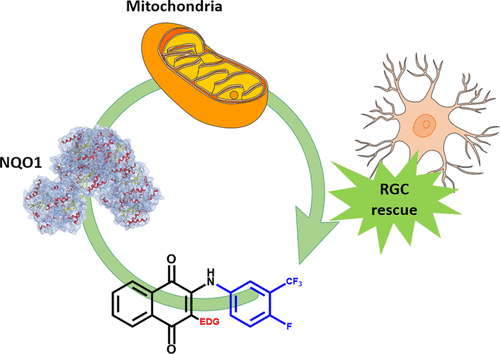当前位置:
X-MOL 学术
›
J. Med. Chem.
›
论文详情
Our official English website, www.x-mol.net, welcomes your
feedback! (Note: you will need to create a separate account there.)
Discovery of Novel 2-Aniline-1,4-naphthoquinones as Potential New Drug Treatment for Leber’s Hereditary Optic Neuropathy (LHON)
Journal of Medicinal Chemistry ( IF 6.8 ) Pub Date : 2020-11-12 , DOI: 10.1021/acs.jmedchem.0c00942 Carmine Varricchio 1, 2 , Kathy Beirne 2 , Pascale Aeschlimann 1, 2 , Charles Heard 1 , Malgorzata Rozanowska 2 , Marcela Votruba 2, 3 , Andrea Brancale 1
Journal of Medicinal Chemistry ( IF 6.8 ) Pub Date : 2020-11-12 , DOI: 10.1021/acs.jmedchem.0c00942 Carmine Varricchio 1, 2 , Kathy Beirne 2 , Pascale Aeschlimann 1, 2 , Charles Heard 1 , Malgorzata Rozanowska 2 , Marcela Votruba 2, 3 , Andrea Brancale 1
Affiliation

|
Leber’s hereditary optic neuropathy (LHON) is a rare genetic mitochondrial disease and the primary cause of chronic visual impairment for at least 1 in 10 000 individuals in the U.K. Treatment options remain limited, with only a few drug candidates and therapeutic approaches, either approved or in development. Recently, idebenone has been investigated as drug therapy in the treatment of LHON, although evidence for the efficacy of idebenone is limited in the literature. NAD(P)H:quinone oxidoreductase 1 (NQO1) and mitochondrial complex III were identified as the major enzymes involved in idebenone activity. Based on this mode of action, computer-aided techniques and structure–activity relationship (SAR) optimization studies led to the discovery of a series naphthoquinone-related small molecules, with comparable adenosine 5′-triphosphate (ATP) rescue activity to idebenone. Among these, three compounds showed activity in the nanomolar range and one, 2-((4-fluoro-3-(trifluoromethyl)phenyl)amino)-3-(methylthio)naphthalene-1,3-dione (1), demonstrated significantly higher potency ex vivo, and significantly lower cytotoxicity, than idebenone.
中文翻译:

新型2-苯胺-1,4-萘醌的发现作为Leber遗传性视神经病(LHON)的潜在新药治疗
Leber的遗传性视神经病变(LHON)是一种罕见的遗传线粒体疾病,在英国,至少每1万个人中就有1个人患有慢性视力障碍的主要原因。治疗选择仍然有限,只有少数几种候选药物和治疗方法得到批准或开发中。最近,艾地苯醌已被研究作为治疗LHON的药物疗法,尽管艾地苯醌功效的证据在文献中是有限的。NAD(P)H:醌氧化还原酶1(NQO1)和线粒体复合物III被确定为参与艾地苯醌活性的主要酶。基于这种作用方式,计算机辅助技术和结构-活性关系(SAR)优化研究导致发现了一系列与萘醌有关的小分子,具有与艾地苯醌相当的腺苷5'-三磷酸(ATP)救援活性。在这些化合物中,三种化合物在纳摩尔范围内显示出活性,一种是2-((4-氟-3-(三氟甲基)苯基)氨基)-3-(甲硫基)萘-1,3-二酮(1)显示出比艾地苯醌显着更高的离体效力,和明显更低的细胞毒性。
更新日期:2020-11-25
中文翻译:

新型2-苯胺-1,4-萘醌的发现作为Leber遗传性视神经病(LHON)的潜在新药治疗
Leber的遗传性视神经病变(LHON)是一种罕见的遗传线粒体疾病,在英国,至少每1万个人中就有1个人患有慢性视力障碍的主要原因。治疗选择仍然有限,只有少数几种候选药物和治疗方法得到批准或开发中。最近,艾地苯醌已被研究作为治疗LHON的药物疗法,尽管艾地苯醌功效的证据在文献中是有限的。NAD(P)H:醌氧化还原酶1(NQO1)和线粒体复合物III被确定为参与艾地苯醌活性的主要酶。基于这种作用方式,计算机辅助技术和结构-活性关系(SAR)优化研究导致发现了一系列与萘醌有关的小分子,具有与艾地苯醌相当的腺苷5'-三磷酸(ATP)救援活性。在这些化合物中,三种化合物在纳摩尔范围内显示出活性,一种是2-((4-氟-3-(三氟甲基)苯基)氨基)-3-(甲硫基)萘-1,3-二酮(1)显示出比艾地苯醌显着更高的离体效力,和明显更低的细胞毒性。











































 京公网安备 11010802027423号
京公网安备 11010802027423号